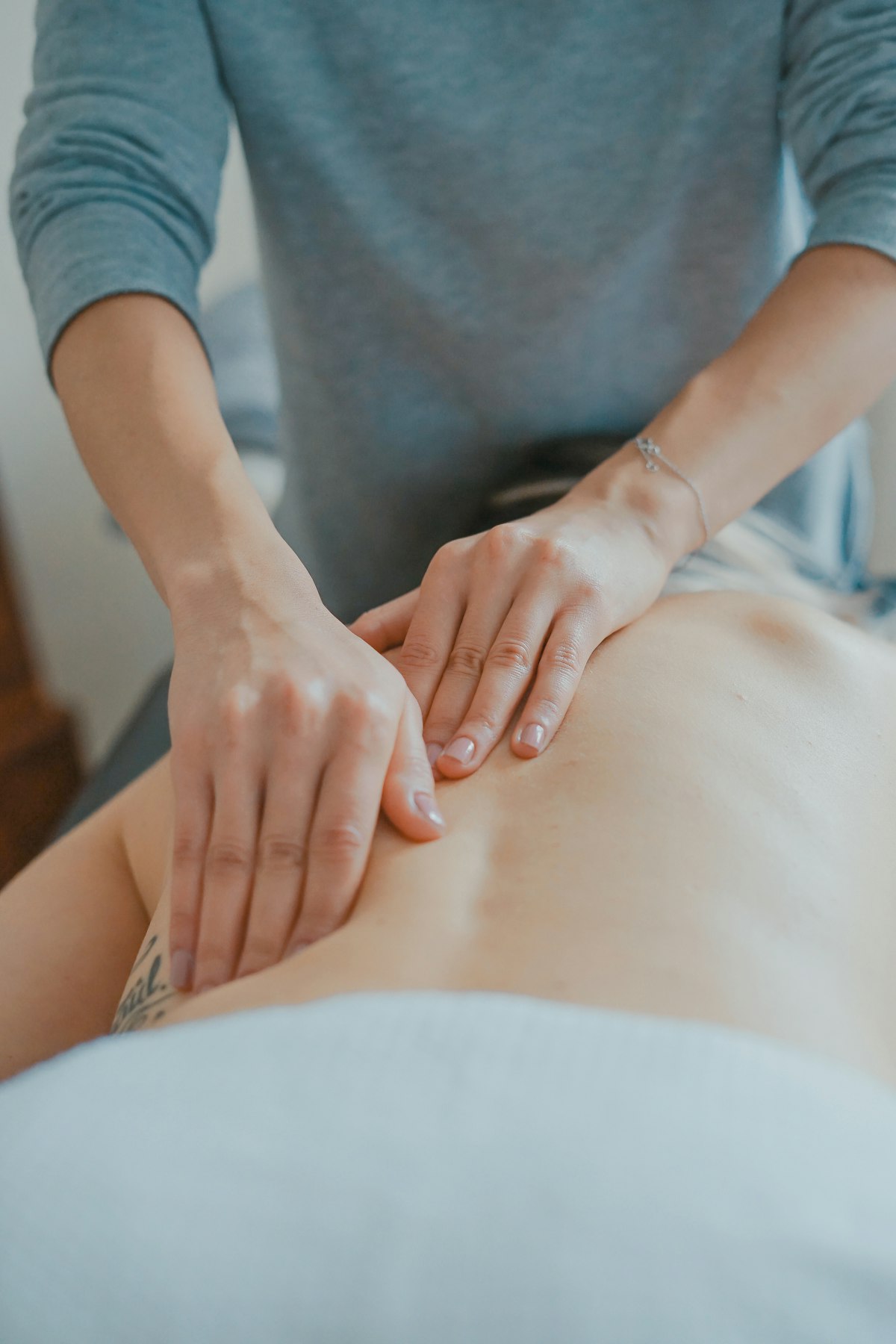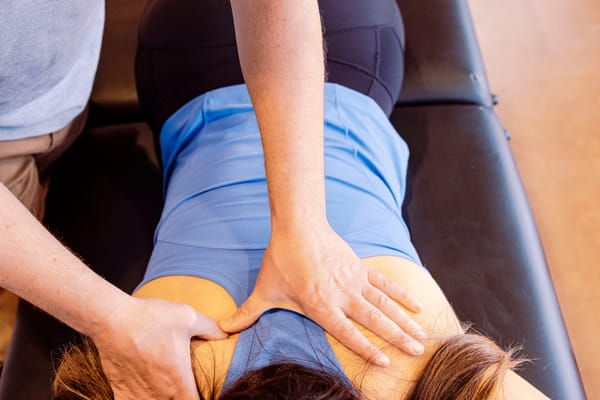
Massage for Hip Pain
Trigger point therapy targets specific tight areas within muscle tissues, known as trigger points, which contribute to hip pain.
Hip Pain and Trigger Point Therapy
Iler Method® Therapists use a specialized form of trigger point therapy tailored to maximize relief and recovery. Regular sessions with our clinical massage therapists can help maintain muscle health, prevent the recurrence of pain, and significantly improve overall function and quality of life for those experiencing chronic or acute hip discomfort.
Trigger point therapy targets specific tight areas within muscle tissues, known as trigger points, which contribute to hip pain. By applying focused pressure to these spots, trigger point therapy releases the tension and knots in the muscles surrounding the hip joint.
This release alleviates direct pain in the hip area and addresses referred pain radiating from the hip to other body parts. The technique effectively reduces muscle stiffness and improves flexibility, decreasing discomfort and enhancing mobility for individuals suffering from hip pain.

Trigger point therapy also promotes increased blood flow to the affected areas, facilitating healing and reducing inflammation. By tackling the underlying muscle tension at the heart of hip pain, this therapy provides a non-invasive and therapeutic route to pain management.
How Hip Pain Presents - Massage
Hip pain, manifesting as discomfort within or around the hip joint, significantly affects mobility and daily functioning. This condition might present as an acute, sharp pain or a persistent, dull ache, hindering everyday activities and potentially diminishing quality of life. Poor blood circulation and issues with soft tissues or the sciatic nerve often contribute to this discomfort, complicating the healing process.
At Iler Method® Therapy, we recognize individuals' diverse experiences with hip pain. Some might feel localized discomfort directly tied to muscle pain, while others endure pain radiating to adjacent areas, often indicative of chronic hip pain. Our skilled therapists focus on providing immediate relief to improve your day-to-day comfort and long-term relief strategies to enhance your overall quality of life.
Common Causes of Hip Pain
- Muscle strains and sprains - Often involve the gluteal muscles and can lead to hip flexor pain, impacting physical activities.
- Tendinitis - Characterized by inflammation of the tendons, particularly around the hip bone, affecting deeper layers of muscles.
- Bursitis - Occurs in the hip, causing discomfort near the hip bone and limiting movement due to inflammation of the bursae.
- Overuse or repetitive stress injuries - Result from continuous physical activities, leading to pain in areas like the lower back and piriformis muscle of the buttock.
- Sciatica - Involves irritation of the sciatic nerve, often related to muscle imbalances, resulting in a sharp pain that radiates from the lower back through the hip.

- Poor posture-related discomfort - This can contribute to muscle imbalances and strain on the hip flexors and gluteal muscles in the hip region.
- Muscle imbalances - Particularly in the hip area, can cause hip flexor pain and affect the stability of the hip bone, hindering physical activities.
- Soft tissue inflammation - Its a condition like hip bursitis where swelling near the hip bone causes significant pain and restricts movement.
Iler Method Massage Techniques for Hip Pain
The Iler Method® Therapy integrates specific static massage holds that support the therapist's body alignment and safety, enabling the application of substantial pressure without risking injury.
This massage approach allows therapists to effectively target and address deep tissue concerns, such as hip pain—a common cause of hip discomfort—while building their physical strength through repetitive movements.
By utilizing this therapy method, therapists can provide high-quality, consistent client care, address the root of hip pain, and promote a healthier practice for themselves.
In contrast to traditional massage techniques that can strain the therapist's body and potentially lead to injury, the Iler Method® offers a sustainable alternative. Techniques like effleurage and petrissage may place undue stress on a therapist’s wrists, hands, and joints, affecting their ability to provide care over time.
By focusing on safe and effective practices, the Iler Method naturally aligns with the needs of clients seeking relief from hip pain, ensuring that therapists can deliver targeted treatments without compromising their physical well-being.

Ring and Middle Finger -
Using the ring and middle fingers together is the go-to technique for addressing hip pain because of their combined strength and structural integrity. These fingers can grip and pull the treated muscle more effectively than any other combination, providing the necessary force to separate and alleviate tightness. The anatomical positioning of these fingers in the middle of the hand allows them to share stress equally, enhancing their ability to apply consistent pressure.
This unique flexion creates a powerful and precise grip, crucial for manually separating overcompensated muscles in the hip area. By targeting the hip muscles with this method, therapists can efficiently reduce pain, improve mobility, and promote healing.
Hand and Fingers over Fingers -
This hand-over-hand technique enhances the treatment experience for clients by enabling deep tissue access in critical areas like the hip and offers a safe way for therapists to apply this pressure. By applying pressure through one hand on top of the other, therapists can effectively target and alleviate tension in hard-to-reach areas, such as the piriformis and gluteus medius, without straining their muscles.
This technique combines the necessity of deep pressure with the finesse of gentle touch, making it perfectly suited for treating deep-seated muscle tension while maintaining the sensitivity required for delicate areas.
Knuckles -
Knuckles, often underutilized in bodywork, offer a simple yet robust means of applying pressure. They are strong, less prone to injury for the therapist, and capable of delivering substantial pressure per square inch, making them particularly effective for more profound, intense work.
Although knuckles may not provide the same level of precision or sensitivity as fingers, their strength is advantageous in the relatively static nature of Iler Method techniques.
Elbow -
The elbow technique is a cornerstone for Iler Method therapists, enabling them to apply considerable focused force precisely where needed. This method is especially potent for treating muscles involved in hip pain, like the Quadratus Lumborum and Gluteus groups, by initially using fingers to locate problematic areas before intensively applying the elbow.
The balanced application of pressure—leveraging not just the arm but the entire body weight supported by key muscle groups—ensures deep tissue engagement.
Final Thoughts - Hip Pain Management
Trigger point therapy offers a practical and non-invasive approach to managing hip pain. Focusing on specific muscle tension areas helps alleviate pain, improve mobility, and promote overall well-being. The Iler Method® employs specialized techniques to ensure effective and safe treatment, benefiting clients and therapists.
Understanding the causes and proper treatment of hip pain is crucial for effective pain management. Through clinical massage methods like the Iler Method, individuals can find relief from chronic discomfort and enhance their quality of life.
FAQs - Hip Pain
Is it good to massage hip pain?
Yes, massaging is good for hip pain. It helps relieve muscle tension and improves circulation around the hip joint.
What is the fastest way to relieve hip pain?
Targeted hip massage therapy, heat application, and gentle stretching exercises are often the quickest ways to alleviate hip pain.
How do you know if hip pain is muscle or joint?
Assessing the nature of the pain, its location, and any associated symptoms like reduced range of motion or swelling helps determine if hip pain is due to muscle or joint issues.
How do you get rid of inflamed hips?
Rest, ice application, anti-inflammatory medications, and precise massage techniques can reduce inflammation in the hips, improving circulation and reducing muscle tension.
Does massage help with hip pain?
Yes, good news: massage helps alleviate hip pain by relaxing tight muscles, increasing blood flow, and reducing inflammation in the affected area.
Can a massage cause hip pain?
Yes, massage is effective for ongoing hip pain as it aids in loosening tight muscles, enhancing circulation, and providing relief from discomfort for the entire body.
Is massage therapy good for hip arthritis?
Yes, massage therapy is a good way to treat arthritis, as it helps reduce stiffness and pain while improving mobility and overall joint function.
Disclaimer: Please note that at Iler Method® Therapy, we specialize in massage therapy and related techniques. All clients must understand that we are not medical professionals, and our services should not be seen as a substitute for medical advice, diagnosis, or treatment. Our practices are designed to support and complement your overall health, but they do not replace professional medical consultation when needed.




